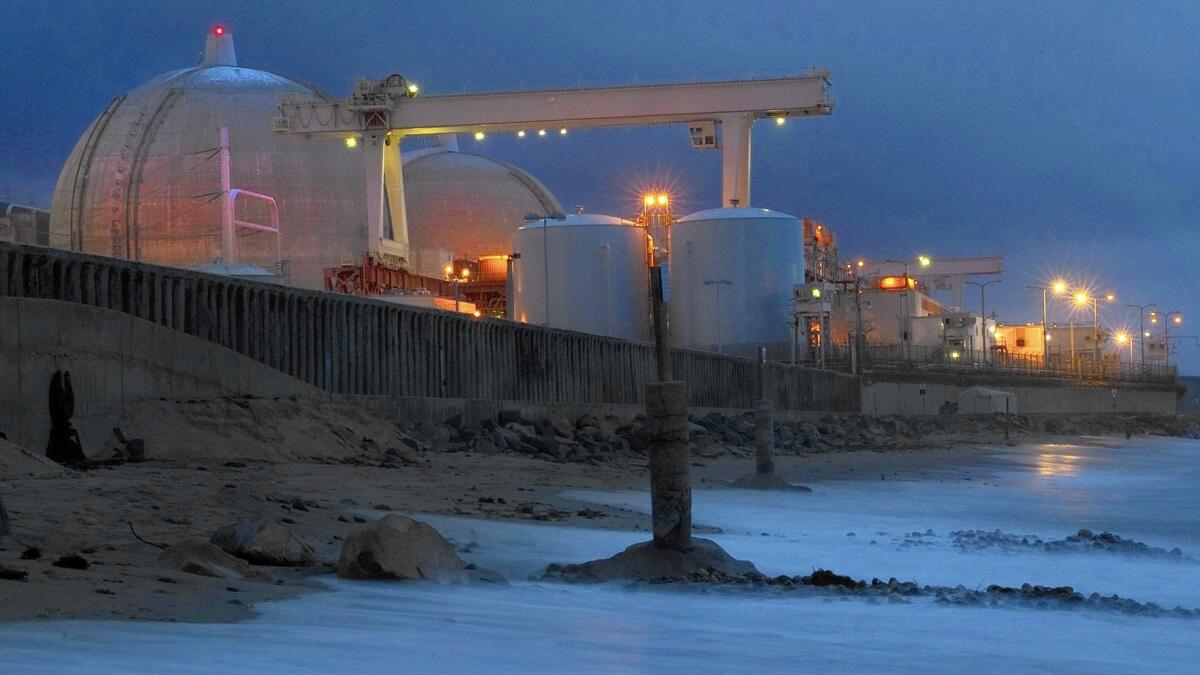Opinion: California’s San Onofre nuclear plant is a Chernobyl waiting to happen

- Share via
Nuclear accidents often aren’t surprises. Whistleblowers had warned of the dangers before such disasters occurred in 1986 in Chernobyl, Ukraine, and 25 years later in Fukushima, Japan. As one of the world’s wealthiest and most technologically advanced nations, the U.S. may be no better prepared.
Many U.S. states have aging nuclear power plants brimming with four decades of self-heating, highly corrosive and toxic radioactive waste. Last month, the California Coastal Commission gave Southern California Edison permission to dismantle the San Onofre Nuclear Generating Station and move its 3.55 million pounds of nuclear waste from wet to dry storage.
Local activists cheered after the troubled San Onofre plant was permanently shut down in 2013 after a 75-gallon-a-day radioactive leak was discovered in a new steam generator. Closing it didn’t stop the threat. Now activists must wait until the plant’s nuclear waste is removed to a yet-to-be-built national nuclear waste repository or until the waste decays in several thousand years, whichever comes first.
Last year, as a crane operator maneuvered to place a 50-ton cask of spent nuclear fuel into a storage vault, the massive cask got caught on an inch-thick steel guide ring and hung there for about an hour. Workers at the site were not prepared for such a dangerous complication.
If the canister had fallen and leaked radioactive gas or liquids, the 18-foot plunge could have led to a panicked evacuation along the coast of California. Even with thoughtful planning, safeguarding people and the environment from a nuclear accident is a complex problem, affirmed a recent report by the International Commission on Radiological Protection.
After Chernobyl, scientists employed by the nuclear industry asserted that the world’s worst nuclear accident killed only a couple dozen people.
In an examination of more than 25 archives in Russia, Ukraine and Belarus, I found that most of the official Chernobyl accounts are incomplete or misleading. Forty thousand people were hospitalized the summer after the accident from Chernobyl exposures, not the 300 Soviet officials claimed.
The effect of the Chernobyl disaster on the region’s population is staggering. Radioactive contaminants migrated toward population centers in dust, water, airways and food. Thyroid disease, autoimmune disorders, anemia, and diseases of the circulation system, digestive tract and lungs increased year by year. Leukemia, pediatric thyroid cancer, and cancers of the mouth, throat and stomach followed.
Belarusian and Ukrainian leaders begged the United Nations General Assembly for aid to move 200,000 more people from contaminated land, and for a long-term study on low doses of radiation on health. The aid never came. It didn’t help that other U.N. agencies, especially the International Atomic Energy Agency, asserted that increased health problems in Chernobyl-contaminated territories had nothing to do with nuclear fallout.
To this day, the scientific community will say that little is known about the effects of chronic exposures to low doses of radioactivity on human health. Belarusian and Ukrainian farmers have been left to deal with the costs of the accident, not a now-defunct power company of a long-gone Soviet government.
Southern California Edison shuttered the San Onofre plant, but the danger lives on. The nuclear waste storage facility sits on an erosion-prone bluff 2 feet above the mean high tide. Seismic activity often occurs, and four tsunamis hit the region between 1812 and 1930. Geologists say the potential for another tsunami is elevated in the area, which has 8.4 million people living within a 50-mile radius.
The lack of preventive measures at San Onofre is disturbing. There is no procedure in place to remove the 50-ton casks of highly radioactive waste from their vaults in response to changing environmental conditions such as erosion or rising sea levels. There is no budget to inspect the spent fuel, nor funds to transfer radioactive waste from thin-walled to sturdier thick-walled casks. In the event of corrosion and loss of containment, there are no procedures in place to repair or slow the leak of radioactive contaminants.
Humans will need to manage San Onofre’s nuclear waste for thousands of years. Scientists may be dubious about evidence of health problems from previous nuclear disasters, but the history of cigarette smoking and climate change illustrates how easy it is for industry advocates to generate doubt as a way to sidestep costs associated with controversial issues.
Greg Jaczko, a former chairman of the Nuclear Regulatory Commission, recently changed his mind about the safety and feasibility of nuclear power after witnessing how lobbyists campaigned to undercut recommended safety regulation changes following the Fukushima accident, which is expected to cost more than $500 billion to clean up over the next four decades. Sadly, the International Commission for Radiological Protection no longer says, “it couldn’t happen here.” Instead, the group schools the public on how to deal with radioactive contaminants in their environment “as a key factor to control radiation exposure.”
Instead of responding retroactively to more radioactive leaks at San Onofre — or worse, a full-scale disaster — industry and government officials should proceed with what regulators call “the precautionary principle.” It places the burden of proof of harm on industry and government agencies, not on those who will be injured. Since no insurance covers the full cost of a nuclear accident, taxpayers will be responsible for shouldering part or all of the cleanup and health-related costs.
Storing spent nuclear fuel on the sites of shuttered nuclear power plants is foolhardy. Radioactive waste should be removed sooner than later from our ever-more vulnerable coastlines — and to prevent another nuclear accident at San Onofre.
Kate Brown is a professor of science, technology and society at the Massachusetts Institute of Technology. Her latest book is“Manual for Survival: A Chernobyl Guide to the Future.”
More to Read
A cure for the common opinion
Get thought-provoking perspectives with our weekly newsletter.
You may occasionally receive promotional content from the Los Angeles Times.










